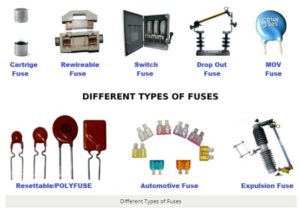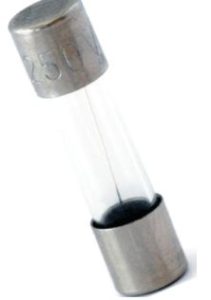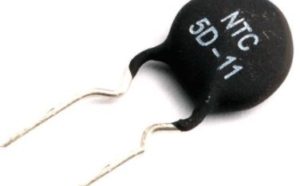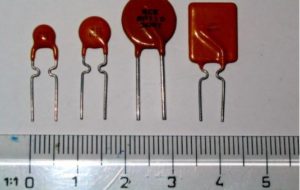
What is a Electrical Fuse?
A fuse is probably the simplest electrical device, but its function is critical in protecting electrical circuits from damage. Fuses are found in every circuit in one form or another in various shapes, sizes, and ratings. In this article, we will learn how a fuse works and about the different types of the fuse.
Symbol of a Fuse
The standard IEEE/ANSI symbols for the fuse is as follows:

How does a fuse work?
The primary job of a fuse is to break the circuit if a current higher than desired is drawn by the circuit, thus preventing damage due to short circuits.
The simplest kind of fuse consists of a resistive element, selected carefully for its melting point. When a current passes through this element, a small voltage drop (small enough so the circuit downstream won’t be affected) is created across the element, and some power is dissipated as heat. The temperature of the element thus increases. For normal currents, this temperature increase is not enough to melt the filament. However, if the current draw exceeds the rated current of the fuse, the melting point is quickly reached. The resistive element melts and the circuit is interrupted. The thickness and length of the resistive element determine the rated current.
Fuse elements are made of zinc, copper, silver, aluminium or other alloys to provide predictable trip currents. The element must not oxidize or corrode over time.
Types of Fuse (DC/AC)
Fuses can be divided into two major categories, AC fuses, and DC fuses. The below block diagram illustrates the different types of the fuse under each category. We will discuss each fuse in brief in our article.

1. AC Fuses
The AC fuses are categorised into two types they are the low voltage fuses and the high voltage fuses. The frequency of the AC fuses changes it amplitude from 0º to 60º in very one second. Thus, the arc extinction in the AC circuit can be done easily as compared to the DC circuit.

The low voltage fuses can be further divided into four classes shown below in the image Semi-enclosed or rewirable type and totally enclosed, or cartridge type switches are the most commonly used switches.

Rewirable Fuses
This type of circuit is mostly used in the small current circuit or for domestic wiring. The fuse case and the fuse carrier are the two main parts of the rewirable fuse. The base of the fuse is made up of porcelain, and it holds the wires which may be made up of lead, tinned copper, aluminium or alloy of tin-lead. The fuse carrier can be easily inserted or taken out in the base without opening the main switch.
Totally Enclosed or Cartridge Type Fuses
The fuse element is totally enclosed in an enclosed container, and it has metal contacts on both sides. These fuses are further classified as D-type cartridge fuses and the Link type cartridge fuses.

D-Type Cartridge Fuses
The main parts of the D-type fuse are the base, adapter ring, cartridge and a fuse cap. The cartridge is kept in the fuse cap, and the fuse cap is fixed to the fuse base. The cartridge tip touches the conductor when it is completely screwed to the base and thus completes the circuit through the fuse links.
Link Type Cartridge or High Rupturing Capacity
In such type of fuses, the fuse element carries the fault current for a long duration. If the fault is not clear, then the fuse element will melt and open the circuit. The major advantage of HRC fuse is that it clears the low as well as a high fault current.
HRC fuse has the high-speed operation and also does not require maintenance. But the fuse element of the HRC fuses needs to be replaced after each operation, and it also produced the heat during the faults which will affect the operations of the nearby switches.
The enclosure of the HRC fuse is filled with powdered pure quartz, which acts as an arc extinction medium. The silver and copper wire is used for making the fuse wire. The fuse wire has two or more sections which are joint by using tin-joint. The tin-joint reduces the temperature under overloaded condition.
For increasing the breaking capacity of the fuses two or more silver wire is joined in parallel with each other. These wires are adjusted in such a way so that only one wire will melt at a time. The HRC fuse is of two types

In knife blade type switches the fuse wire is replaced with a live circuit with the help of fuse puller.The bolted type HRC fuses have two conducting plates which are bolted to the fuse base. This fuse requires the additional circuit for taking out the switch without getting a shock.
Dropout Fuse
The melting of fuse causes the fuse element to drop out under gravity about its lower support. Such type of fuse is used for the protection of outdoor transformers.
Striker Fuse
It is a mechanical device having enough force and displacement which can be used for closing tripping/indicator circuits.
Switch Fuse
Such type of switches is used for low and medium voltages circuit. The rating of the fuse unit is in the range of 30, 60, 100, 200, 400, 600, and 800 amperes. The fuse unit is available as 3-pole and 4-pole unit. The making capacity of such type of fuses is up to 46 kA. They can safely break depending upon rating currents of the order of 3 times the load current.
High Voltage HRC Fuses
The main problem of the high voltage fuses is that of the corona. Therefore the high voltage fuses have the special design. They are mainly classified into three types.

Cartridge Type HV HRC Fuse
The fuse element of the HRC fuse is wound in the shape of the helix which avoids the corona effect at the higher voltages. It has two fused elements placed parallel with each other, one of low resistance and the other is of high resistance. The low resistance wire carries the normal current which is blown out and reducing the short circuit current during the fault condition.
Liquid Type HV HRC Fuse
Such type of fuses is filled with carbon tetrachloride and sealed at both the ends of the caps. When the fault occurs then the current, exceed beyond the permissible limit, and the fuse element is blown out. The liquid of the fuse acts as an arc extinguishing medium for the HRC fuses.They may be employed for the transformer protection and the backup protection to the circuit breaker.
Expulsion Type HV Fuse
Expulsion type fuses are widely used for the protection of feeders and transformer because of their low cost. It is developed for 11kV, and their rupturing capacity is up to 250 MVA. Such type of fuses comprises a hollow open-ended tube made of synthetic resin-bonded paper.
The fuse elements are placed in the tubes, and the ends of the tubes are connected to suitable fittings at each end. The arc producing is blown off in the inner coating of the tube, and the gases thus formed extinguish the arc.
2. DC Fuses
1.CARTRIGE FUSES
This is the most common type of fuse. The fuse element is encased in a glass envelope that is terminated by metal caps. The fuse is placed in an appropriate holder. Since the glass envelope is clear, it is easy to visually determine if the fuse is blown.

There are many variants of this design, including slow blow fuse and fast blow fuse. Slow blow fuses have a larger element that can handle overcurrent for a relatively short period of time and are unaffected by spikes in the appliance. Fast blow fuses react instantly to current spikes.
Some variants of this fuse are encased in ceramic to withstand high temperatures. Fuses for high voltage applications are filled with sand or oil. This is to prevent arcing between the two ends of the fuse after it has blown. SMD variants of cartridge fuses also exist for direct PCB mounting.
2. AUTOMOTIVE FUSES

These fuses are specifically designed for automotive systems that run up to 32V and occasionally 42V. They come in ‘blade’ form (a transparent plastic envelope with flat contacts) and are colour coded according to rated current. Some of these types are also used in other high-power circuits.
3.SEMICONDUCTOR FUSES
The power dissipated by a semiconductor increases exponentially with current flow, and hence semiconductors are used for ultrafast fuses. These fuses are usually used to protect semiconductor switching devices that are sensitive to even small current spikes.
4.OVERVOLTAGE SUPPRESSION
Sometimes voltage spikes can be harmful to circuits too, and often an overvoltage protection device is used with a fuse to protect against both voltage and current spikes.
NTCs (negative temperature coefficient) are placed in parallel with the supply. When the supply voltage spikes, NTC Fuses decrease resistance due to higher current flow and ‘absorb’ spikes.

Metal oxide varistors (MOVs) are semiconductor like devices that bidirectionally absorb voltage spikes. You can learn more about MOV and its working using the linked article.
5. RESETTABLE FUSES/POLYFUSE

They contain carbon black particles embedded in organic polymers. Normally, the carbon black makes the mixture conductive. When a large current flows, heat is generated which expands the organic polymer. The carbon black particles are forced apart, and conductivity decreases to the point where no current flows. Conductivity is restored as temperature decreases. Thus, the fuse does not have to be physically replaced. This kind of fuse is also called a PTC, meaning positive temperature coefficient, since resistance increases with temperature.
PTC Fuse is ubiquitous in computer power supplies and phone chargers. They are particularly handy here since replacement is difficult. For the same reason, they are used in aerospace devices.
PTCs are easily identified by their yellow-orange colour and disc (and occasionally rectangular) shape in their through-hole variants. SMD poly fuses usually come in green with white markings or black with gold markings. PTCs are available in virtually every current rating.
Advantages of an Electrical Fuse
- It is the cheapest form of protection, and it does need any maintenance.
- Its operation is completely automatic and requires less time as compared to circuit breakers.
- The smaller sizes of fuse element impose a current limiting effect under short-circuit conditions.
- Its inverse time-current characteristic enables its use for overload protection.
Disadvantages of an Electrical Fuse
- Considerable time is required in replacing a fuse after the operation.
- The current-time characteristic of a fuse cannot always be correlated with that of the protective device.
Fuses are used for the protection of the cables in low voltages light, and power circuits and for transformers of rating not exceeding 200 KVA, in the primary distribution system. Fuses are used in low and moderate voltage applications where the frequent operation is not expected or where the use of a circuit breaker is uneconomical.